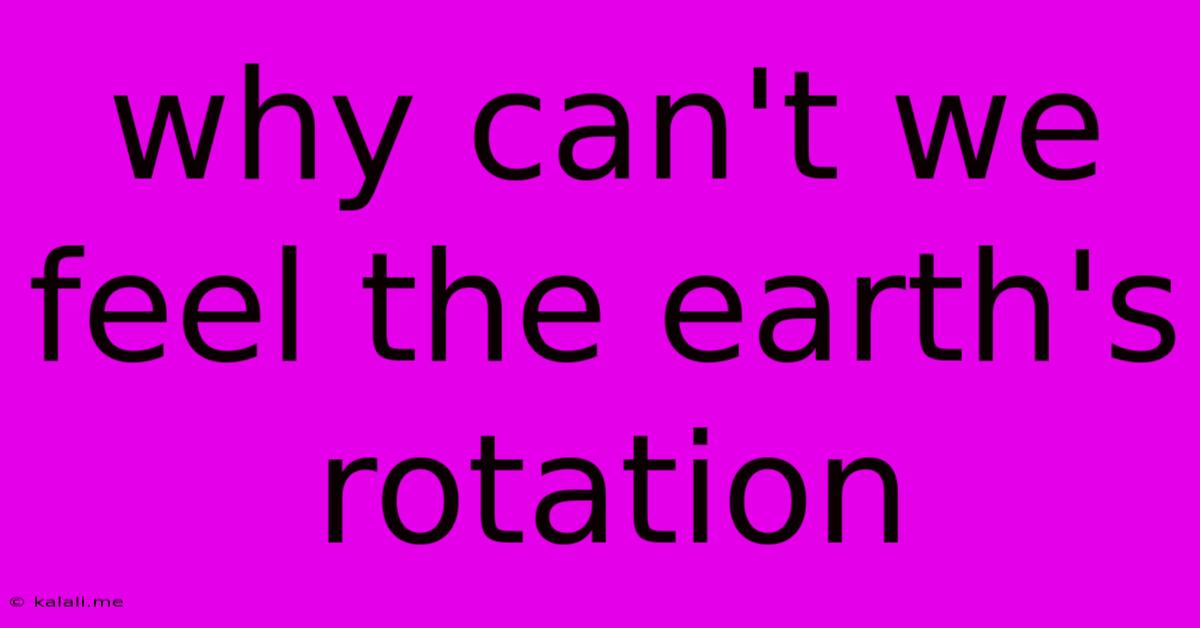Why Can't We Feel The Earth's Rotation
Kalali
May 22, 2025 · 2 min read

Table of Contents
Why Can't We Feel the Earth's Rotation?
We live on a planet spinning at an incredible speed – roughly 1,000 miles per hour (1,600 kilometers per hour) at the equator. Yet, we don't feel this dizzying rotation. Why is that? The answer lies in the concepts of inertia, scale, and constant velocity. This article will delve into the physics behind this fascinating phenomenon, explaining why we experience a stable, stationary world despite the Earth's relentless spin.
The Power of Inertia: Our Constant Companion
The key to understanding why we don't feel the Earth's rotation is inertia. Inertia is the tendency of an object to resist changes in its state of motion. Everything on Earth, including ourselves, the atmosphere, and the oceans, is moving at the same speed as the Earth's rotation. We are all essentially rotating with the Earth.
Think of it like being on a smoothly moving train. As long as the train maintains a constant speed, you don't feel the movement unless you look outside. Similarly, because we and everything around us are moving at the same constant speed, we don't feel the Earth's spin.
Scale and Perspective: The Immense Earth
The Earth is incredibly large. Its vast size means that the rotational speed, while fast in terms of miles per hour, translates to a gradual, almost imperceptible angular velocity. The Earth takes a full 24 hours to complete one rotation. This slow, consistent turn contributes to our inability to detect it directly.
Constant Velocity: A Smooth Ride
The Earth's rotation is remarkably consistent. There are no sudden starts or stops, no jolts or accelerations. It's a constant, uniform movement. We only feel motion when there's a change in velocity – acceleration or deceleration. Because the Earth's rotational speed remains largely constant, we don't perceive any motion.
Other Factors to Consider:
- Gravity: Earth's gravity holds us firmly to the surface, countering any centrifugal force from the rotation. While there is a slight centrifugal effect, it's far outweighed by the force of gravity.
- Atmospheric Movement: The atmosphere rotates with the Earth, creating a stable environment around us.
Misconceptions and Clarifications:
Some may mistakenly attribute the lack of sensation to the Earth's size, but this is only part of the picture. While the Earth's massive size contributes to the slow angular velocity, the main reason is the uniform, constant velocity of the rotation and the principle of inertia.
Conclusion:
Our inability to feel the Earth's rotation is a testament to the power of inertia and the consistent, large-scale nature of the Earth's movement. It's a fascinating example of how our perception can be influenced by the scales and forces at play in the universe. We experience a stable world because we are, quite literally, moving in perfect harmony with our planet.
Latest Posts
Latest Posts
-
How Do You Get Hair Dye Off Walls
May 22, 2025
-
How To Take Off Power Armor Fallout 4
May 22, 2025
-
Too Full Of The Milk Of Human Kindness Analysis
May 22, 2025
-
Where Do I Find Bookmarks On My Phone
May 22, 2025
-
Can You Take Hairspray In Your Checked Luggage
May 22, 2025
Related Post
Thank you for visiting our website which covers about Why Can't We Feel The Earth's Rotation . We hope the information provided has been useful to you. Feel free to contact us if you have any questions or need further assistance. See you next time and don't miss to bookmark.